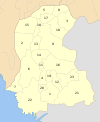Khairpur District
At the 2017 census, it was the fifth most populated district in the province after four districts of Karachi city, with 2.4 million inhabitants. The headquarters of the district is the city of Khairpur. The district is further divided into eight sub-districts: Khairpur Tehsil, Mirwah Tehsil, Kot Diji Tehsil, Kingri Tehsil, Sobho Dero Tehsil, Gambat Tehsil, Faiz Ganj Tehsil and Nara Tehsil.
Location
Khairpur district is located between middle and northern Sindh. It is bounded on the north by Shikarpur District and Sukkur District, on the east by India, on the south by Sanghar District and Nawabshah District, and on the west by Larkana District, Naushahro Feroze District and Indus River. The revised area of the district is 15,910 km.
Demographics
| Year | Pop. | ±% p.a. |
|---|---|---|
| 1951 | 347,068 | — |
| 1961 | 500,258 | +3.72% |
| 1972 | 724,935 | +3.43% |
| 1981 | 981,190 | +3.42% |
| 1998 | 1,546,587 | +2.71% |
| 2017 | 2,405,190 | +2.35% |
| 2023 | 2,597,535 | +1.29% |
| Sources: | ||
As of the 2023 census, Khairpur district has 452,250 households and a population of 2,597,535. The district has a sex ratio of 102.69 males to 100 females and a literacy rate of 50.14%: 61.84% for males and 38.10% for females. 891,260 (34.31% of the surveyed population) are under 10 years of age. 844,263 (32.50%) live in urban areas.
| Religion | 1941 | 2017 | 2023 | |||
|---|---|---|---|---|---|---|
| Pop. | % | Pop. | % | Pop. | % | |
| Islam |
253,690 | 82.96% | 2,336,821 | 97.16% | 2,513,753 | 96.78% |
| Hinduism |
49,604 | 16.22% | 66,489 | 2.76% | 75,407 | 2.90% |
| Sikhism |
1,616 | 0.53% | — | — | 28 | ~0% |
| Others | 877 | 0.29% | 1,880 | 0.08% | 7,951 | 0.32% |
| Total Population | 305,787 | 100% | 2,405,190 | 100% | 2,597,448 | 100% |
The majority religion is Islam, as indicated by 96.78% of the population. Hinduism is practiced by 2.90% of the population, including those from Scheduled Castes.
Sindhi was the predominant language, spoken by 97.73% of the population as their first language.
Politics
The National Assembly.
The District of Khairpur is mapped into three constituencies at the national level. The constituencies include NA-208 Khairpur-I, NA-209 Khairpur-II, and NA-210 Khairpur-III.
Following is the list of the Member National Assemblies(MNAs) representing district in the National Assembly of Pakistan.
| Member of National Assembly | Constituency | Party | Election Year |
|---|---|---|---|
| Syed Nafisa Shah | NA-208 Khairpur-I | PPP | 2018 |
| Syed Javed Shah | NA-209 Khairpur-II | PPP | 2018 |
| Syed Fazal Shah | NA-210 Khairpur-III | PPP | 2018 |
The Provincial Assembly
The District of Khairpur is represented by the seven constituencies in the Provincial Assembly of Sindh.
| Member of Provincial Assembly | Constituency | Party | Year |
|---|---|---|---|
| Syed Qaim Ali Shah | PS-26 Khairpur-I | PPP | 2018 |
| Munawar Wassan | PS-27 Khairpur-II | PPP | 2018 |
| Sajid Banbhan | PS-28 Khairpur-III | PPP | 2018 |
| Muhammad Rafique Banbhan | PS-29 Khairpur-IV | GDA | 2018 |
| Syed Fazal Ali Shah | PS-30 Khairpur-V | PPP | 2018 |
| Naeem Ahmed Kharal | PS-31 Khairpur-VI | PPP | 2018 |
| Syed Rashid Shah Rashidi | PS-32 Khairpur-VII | GDA | 2018 |
Administration
It has 8 tehsils, 76 Union councils, 11 towns, 6800 Villages and total population 1,546,587 (Male 810,448 and Female Population 736,139) according to (Census) 1998.
The eight tehsils of the district are:
- Faiz Ganj Tehsil
- Gambat Tehsil
- Khairpur Tehsil
- Kingri Tehsil
- Kot Diji Tehsil
- Nara Tehsil
- Sobho Dero Tehsil
- Mirwah Tehsil
People from Khairpur District
- Pir Pagaro - President of Pakistan Muslim League (F)
- Sachal Sarmast - eighteenth-Century Sufi Poet
- Qaim Ali Shah - former Chief Minister of Sindh Province
- Rais Muhammad Malook Shar - former MPA from constituency PS-29, First Taluka Faiz Ganj Chairman, and influential personality
- Ghous Ali Shah - former Defense Minister of Pakistan and Former Chief Minister of Sindh province
- Mir Ali Murad Talpur - former ruler of the princely state of Khairpur
Notes
- ^ 1941 figures are for Khairpur State, which roughly correspond to the present district.
- ^ Including Jainism, Christianity, Buddhism, Zoroastrianism, Judaism, Ad-Dharmis, or not stated
References
- ^ "7th Population and Housing Census - Detailed Results: Table 1" (PDF). Pakistan Bureau of Statistics.
- ^ "Khairpur: then and now - Daily Times". Daily Times. 6 February 2018. Retrieved 16 May 2018.
- ^ "Khairpur District Information". Population Welfare Department, Government of Sindh website. Archived from the original on 28 March 2015. Retrieved 21 January 2024.
- ^ "Population by administrative units 1951-1998" (PDF). Pakistan Bureau of Statistics.
- ^ "7th Population and Housing Census - Detailed Results: Table 9" (PDF). Pakistan Bureau of Statistics.
- ^ "7th Population and Housing Census - Detailed Results: Table 20" (PDF). Pakistan Bureau of Statistics.
- ^ "7th Population and Housing Census - Detailed Results: Table 12" (PDF). Pakistan Bureau of Statistics.
- ^ "7th Population and Housing Census - Detailed Results: Table 5" (PDF). Pakistan Bureau of Statistics.
- ^ "CENSUS OF INDIA, 1941 VOLUME XII SINDH PROVINCE" (PDF).
- ^ "District Statistics (Census - 2017) - Khairpur District". Pakistan Bureau of Statistics.
- ^ "Pakistan Census 2023" (PDF).
Sources
- 1998 District census report of Khairpur. Census publication. Vol. 86. Islamabad: Population Census Organization, Statistics Division, Government of Pakistan. 2000.
